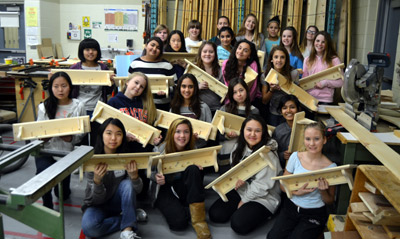 Education Matters/Spring 2015
Education Matters/Spring 2015
Female students from Oakville’s Abbey Park High School and its elementary feeder schools have learned first-hand about viable careers in the trades industry through an introduction program.
Called the Girls in Technology Transition program, students spend a half-day at Abbey Park High School learning about life at high school and building a small project made out of wood. They use hand and power tools under proper guidance and adhering to safety rules and guidelines, stated Tara Ashley, teacher at Abbey Park High School, who oversees the tech program. The most recent program participants from Pilgrim Wood and Heritage Glen Public Schools crafted a wall shelf.
Students are taken on a tour of the school and can ask questions. The experience is facilitated by female students who have taken woodworking and construction programs. Many of the Grade 8 girls recognize their mentors as graduates from their school “so this can be exciting and inspirational for all of the program participants,” Ashley said.
This initiative is intended to address a shortage in the trades industry in Canada while giving girls viable career opportunities, she said.
“In addition to a shortage of students choosing the skilled trades as career pathways, there is a huge gap in the number of females, when compared to males, taking Technological Education courses, as well as, choosing a skilled trade for a career,” Ashley explained. Students learn about high school Technological Education and Construction Technology courses, as well as different pathways that lead to careers in the skilled trades such as Ontario Youth Apprenticeship Program, High Skills Specialist Majors and apprenticeship, she noted.
“Being successful in a program like this will hopefully empower the girls to try a few courses they might not normally have chosen.”
The tech program specifically helps elementary students feel more comfortable when making the transition from elementary school to secondary school by visiting their high school and meeting and working with student mentors and teachers. They also have a chance to participate in a Technological Education course with the hope students may consider tech when they enter Grade 9.
“Hopefully they appreciate the skilled trades more,” Ashley said. “They gain more self-confidence in themselves and in their ability to be successful in areas that are not ‘traditionally female..’”
“Safety is a huge part of the program with the elementary students,” said Barb Finan, OYAP and Pathways Facilitator for the Halton District School Board. “Ashley goes over the safe use of the equipment before students use it.”
Finan said the program is “very hands on, which is attractive to students. They also get to take the project they create home to show their parents and friends. This program is designed to help females realize the skilled trades are a valuable option for them.”
Arielle Zamdvaiz is a recent graduate of Abbey Park High School and is currently enrolled in Dalhousie University’s community design program. She is one of the mentors in Girls in Technology Transition and has loved the opportunity.
“I was delighted to be a mentor for the program as I was able to show girls we are capable of handling tools and machinery. If you don’t try something, then how are you ever supposed to find out if you are good at it? I want other girls to know the satisfaction of building something that starts as just a simple design on paper.”
Finan thinks an initiative like the Girls in Technology Transition program is important because females should feel comfortable considering trades as a future employment possibility. She cited the Canadian Apprenticeship Forum which estimates only 1 in 10 apprentices are female.
“Many girls don’t consider trades as a career path because of the traditional perception that trades are for boys. Trades are for everyone. There is no reason girls shouldn’t consider all skilled trades as a first choice option. If you have an interest in construction, motive power, services or industrial trades, male or female, go for it.”
Women in the skilled trades make up less than 3 per cent of the total Canadian workforce but as baby boomers prepare to retire, it’s estimated 40 per cent of the current trades workforce will need replacing, Finan said.